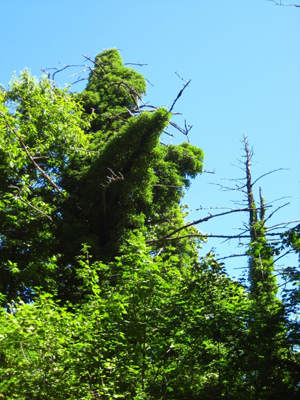
Native to most of Europe, Hedera helix has unfortunately found a happy home here in the Pacific Northwest. It can be seen in many yards and parks and it rivals blackberries as the most common invasive in our district. Ivy is an evergreen climbing vine that will grow 100 or more feet up trees, cliffs, and buildings by hanging on with adhesive rootlets. It has a tendancy to choke out and kill trees as it competes for available sunlight. On the ground it acts like a ground cover, and it forms dense mats that exclude native vegetation.
Identification
The leaves on ivy vines are alternate with a long petiole with a waxy leaf surface. They tend to be leathery to the touch. They are palmately veined (principal veins radiate out from a single point) with five lobes, however, when in full sun the leaves can be unlobed and cordate. The flowers, produced in late summer and fall are very popular with nectar loving insects. The fruits are small black berries that contain glycocide heredin, which can cause toxocosis if eaten.
Control

Ivy has taken over and killed this tree.
Tackling an infestation of ivy is no easy task. If you notice a small infestation do not delay in removing it. The longer one waits to treat ivy, the effort it takes to remedy the situation increases exponentially. On trees we recomend carefully cutting the ivy’s vines and stump treating the cut areas with an appropriate herbicide like Garlon 3-A.
If you have an infestation that is creeping along the ground, get some gardening scissors and some gloves and start pulling and cutting. You can do it! Dispose of the cut material in your yard waste. If you choose to compost it, let it dry out completely, or it will resprout and you will be back at it again.
Unfortunately, due to the widespread occurrence of English ivy, we do not offer control services.
More Photos
To see more photos of English ivy click here
